This document discusses data structures for geographic and cartographic data. It notes that current data structures are characterized by: 1) being designed for input rather than use in programs, 2) storing different feature types in separate uncoordinated files, and 3) lacking information on neighboring entities. The concept of a "neighborhood function" is introduced to indicate an entity's relative location, which is important for analysis. Ongoing research includes the GEOGRAF and GDS systems, which involve manipulating data between input and use to address issues of flexibility, comparability, and topology.
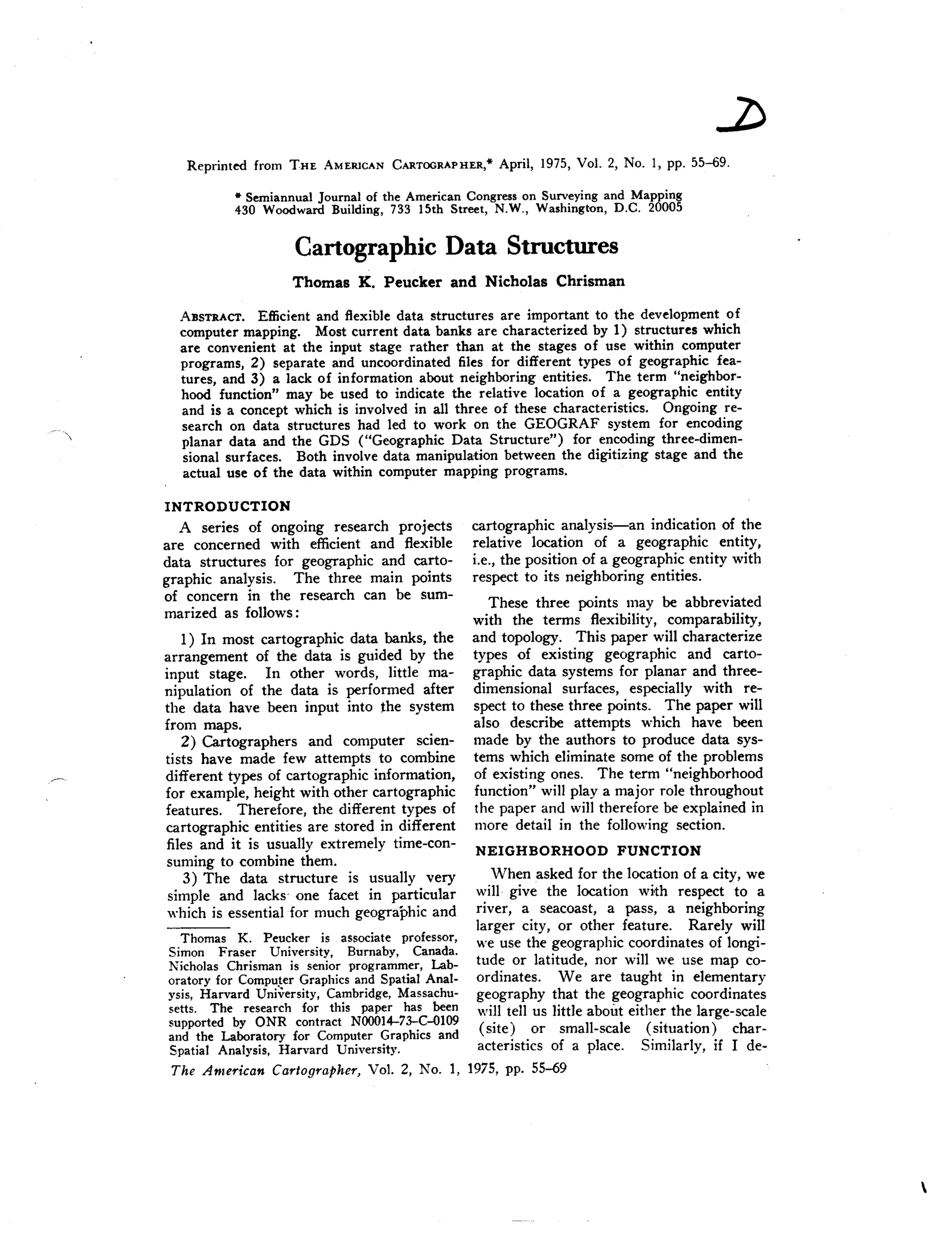
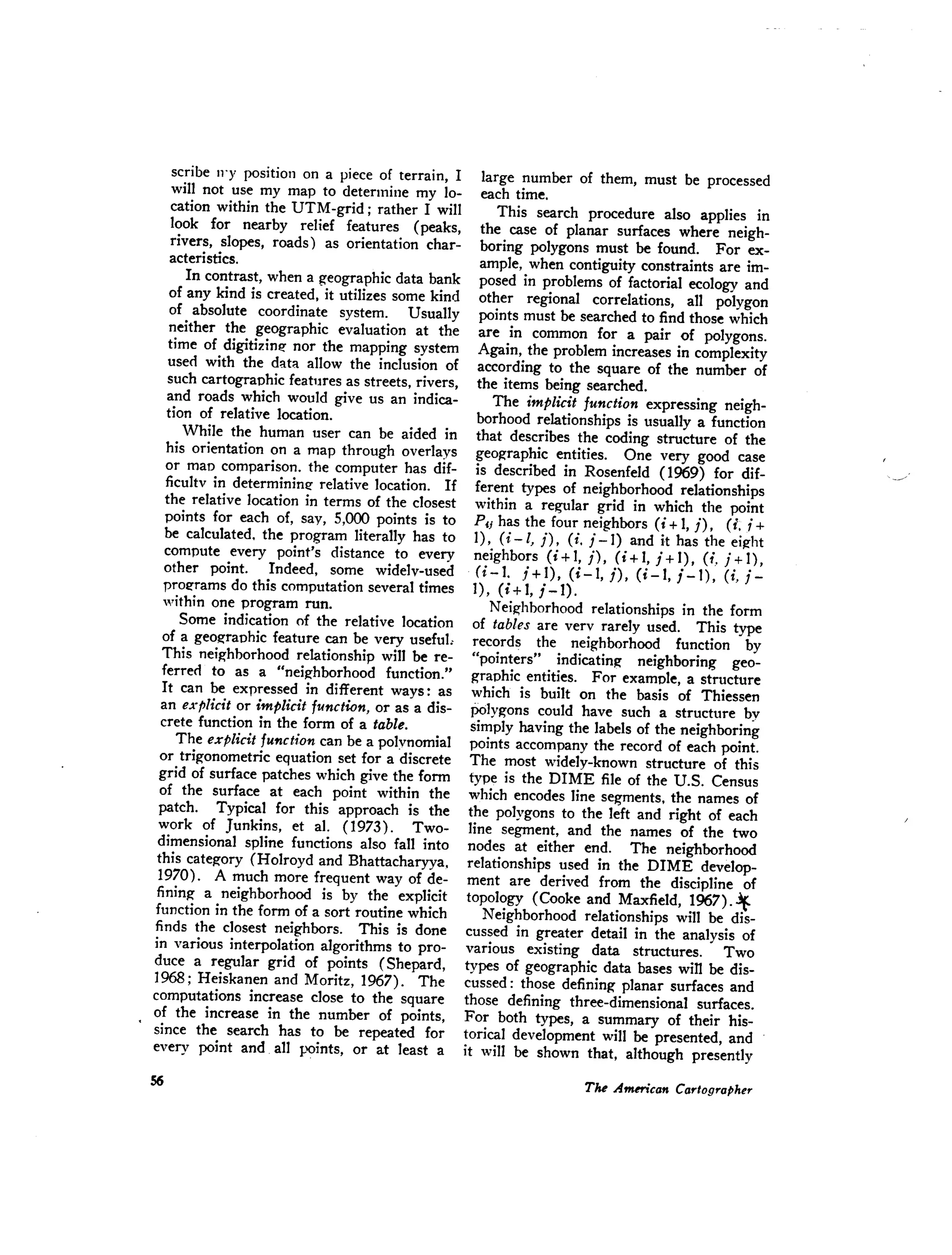
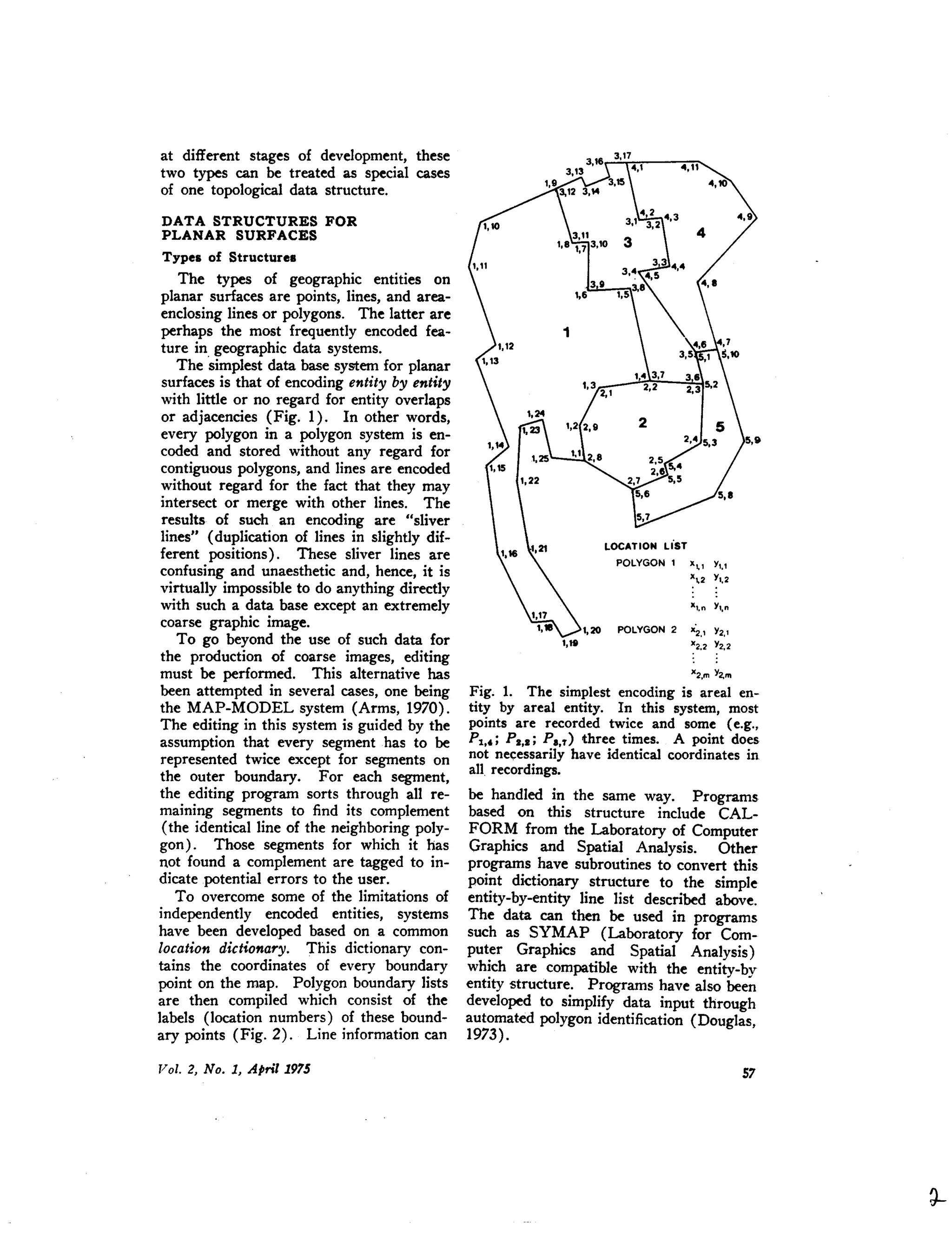
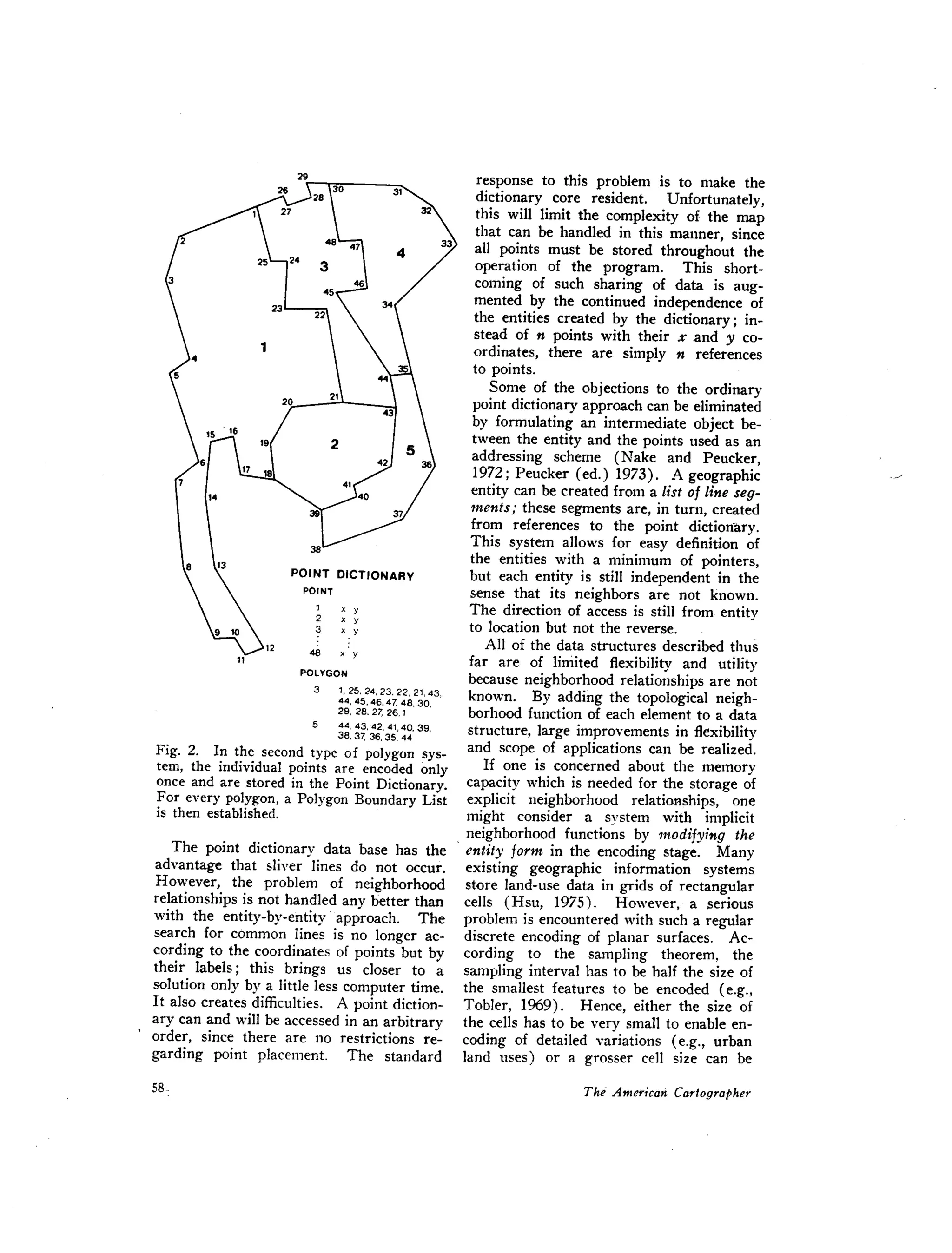

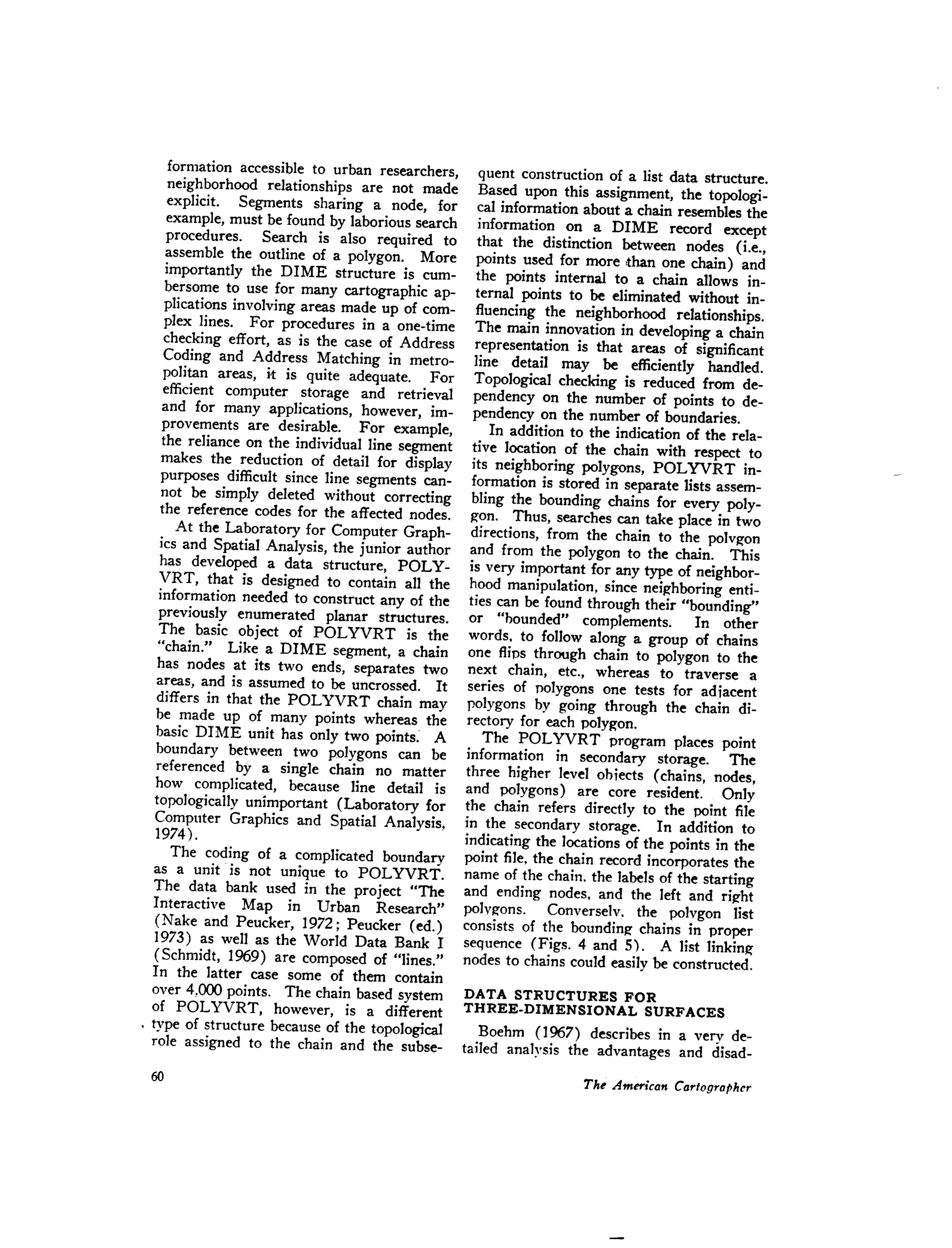
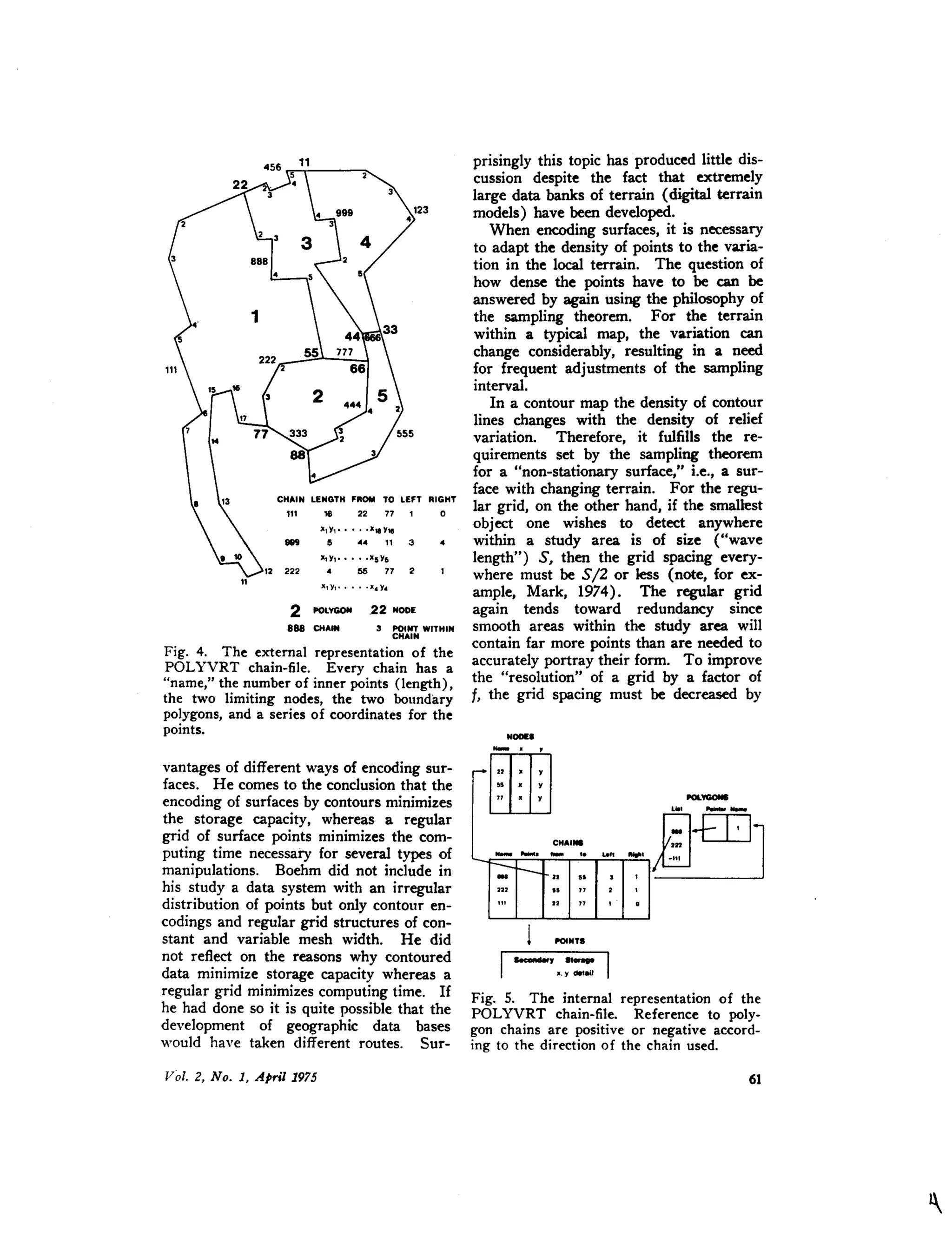
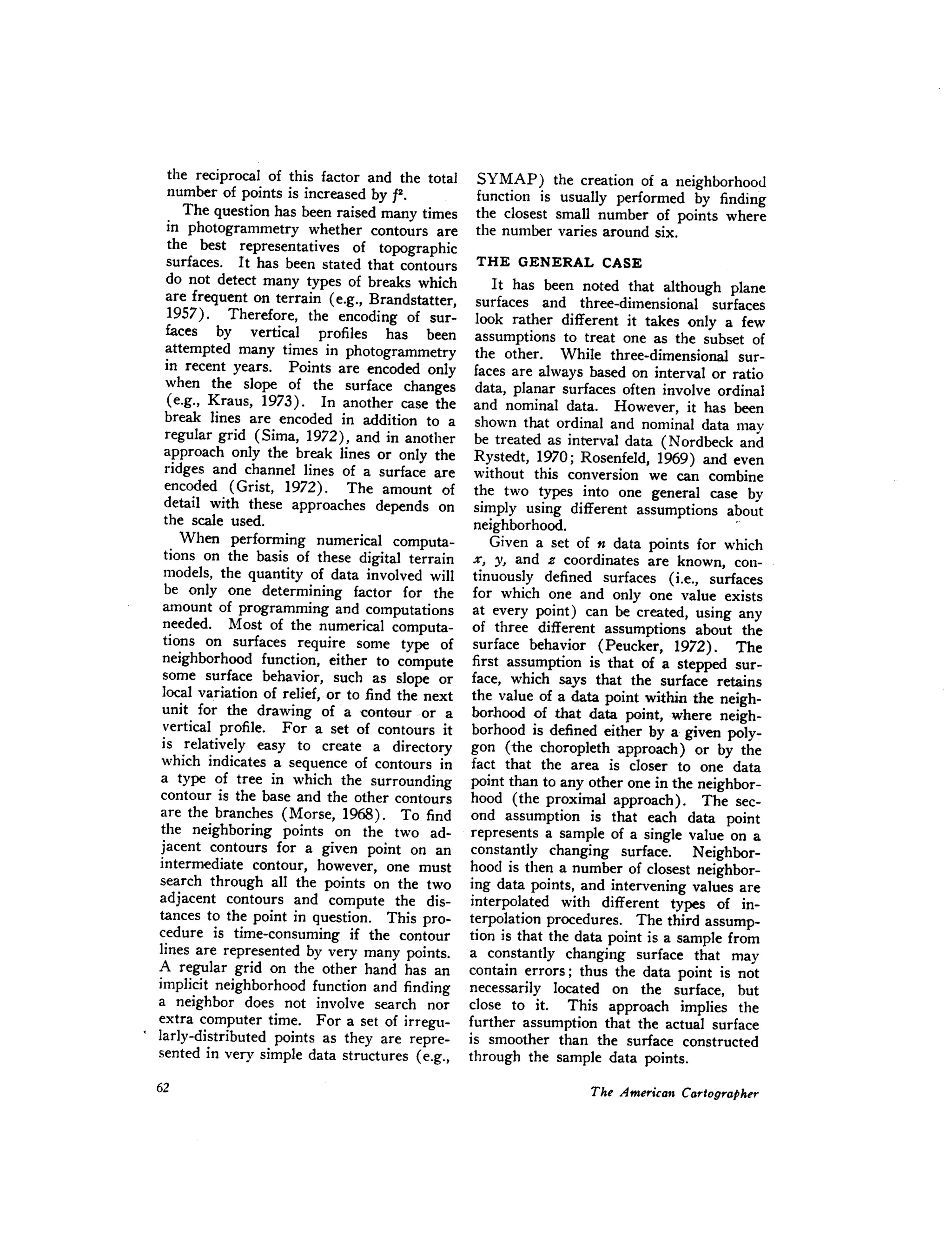
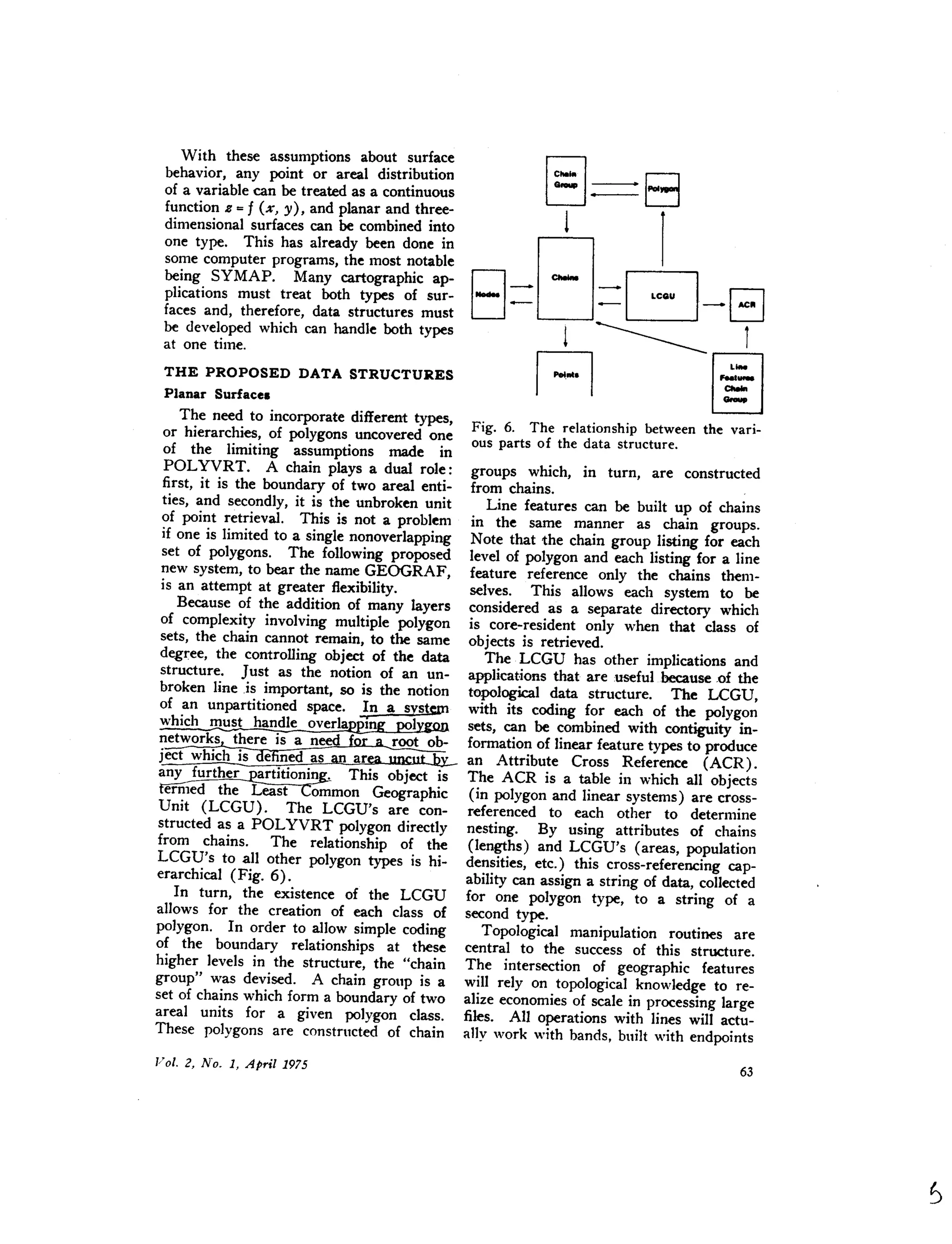
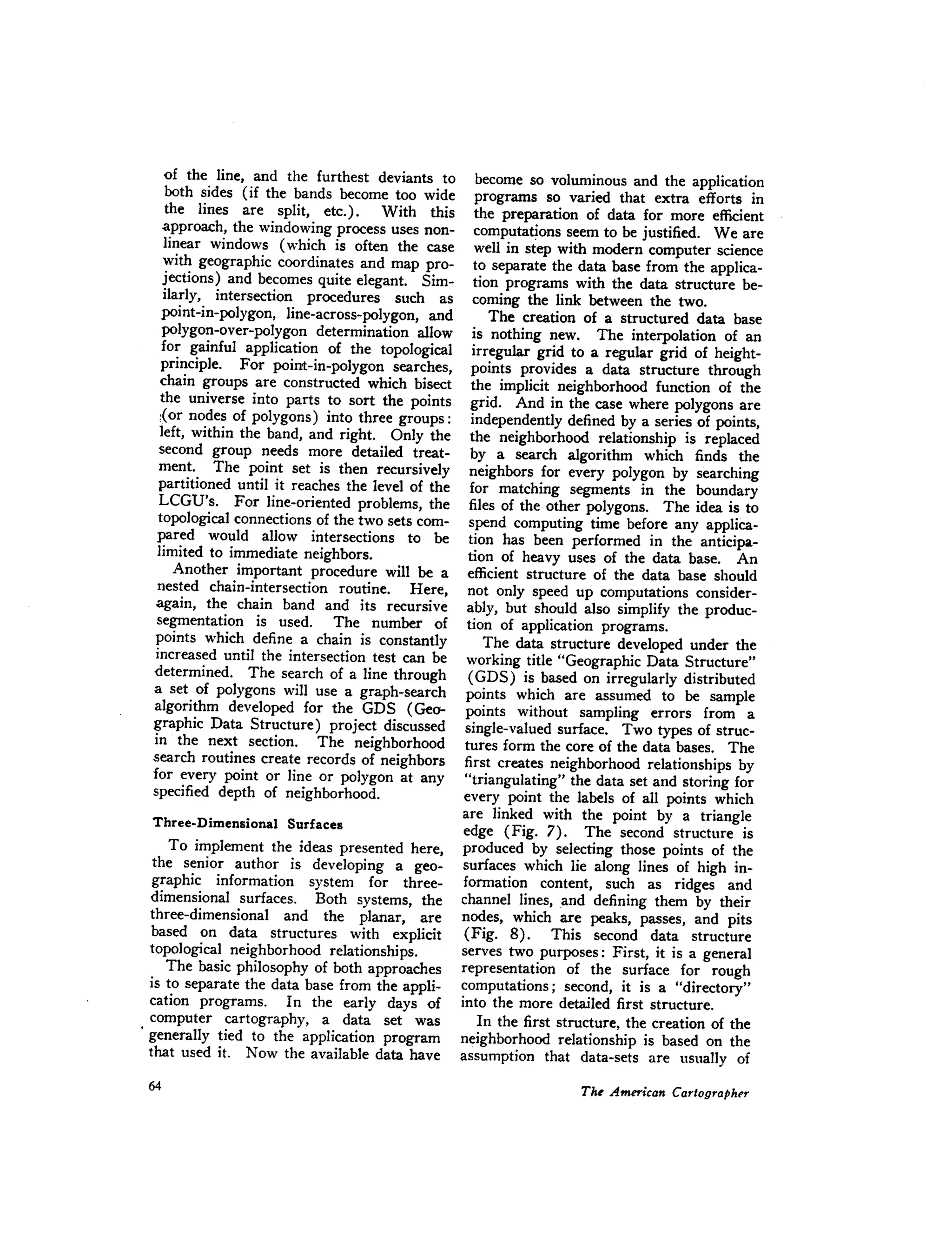
![16 17353415 3
17 _ l' 36 35 16 3,'
16 X Y z i
17 X Y z i+6
l' X Y z j +t3
3_ X Y z j
17
35
34
- 15
2
3
~~
~ ~
l'Fig. 7. The GDS-first data structure. The
illustration shows the points on the surface
with their links to neighbors (edges). The
external representation is shown by the
neighborhood relationships. The internal
representation is composedof the point-file
and the pointer-file.
two types: (a) sets of irregularly-distri-
buted points which were digitized with the
understanding that every point is signif-
icant, and (b) sets of regularly or irregu-
larly-distributed points where it is known
that a number of points are redundant and
can be eliminated from the set, e.g., regular
grids of points and encoded contours.
The first type of data set is linked by
some type of triangulation. At least two
approaches exist. The first (Dueppe and
Gottschalk, 1970) creates all possible links,
chooses the shortest, and eliminates all
links which intersect the shortest. This
procedure is repeated with the next short-
est links until no links intersect. The re-
sult is the set of links with the minimum
cumulative distance between neighboring
points.
The ~rocedure has one disadvantage:
since(~ ) links have to be created, the num-
ber of points is therefore limited to
only several hundred. The first step in
our approach therefore limits the links to
a number of "potential neighbors," among
which the shortest link is chosen and in-
tersected with all other links originating
in these potential neighbors. This pro-
cedure limits the number of tests for in-
n'm
2
tersections of links to less than - ••.-
where m is the number of potential neigh-
bors, an arbitrary number between 8 and
14 depending on the density variation of
these points. The procedure does not
guarantee, however, that only triangles are
constructed; polygons with more than
three sides can result, although they are
relatively rare. The check for such poly-
gons and their elimination is very easy and
fast.
The second possibility is to create a
triangulated structure through use of
Thiessen polygons. A published solution
(Rhynsburger, 1973) intersects for every
point the links to every other point midway
and chooses the smallest polygon created
I
_. CHA. I
~COID~oImJIIL ..•....• ........ER. CHAIN••••• _
[[]]-D D[ _.T ~TA ~ROCT~ JFig. 8. The GDS-second data structure.
Both the node-file and the chain-file have
access to the first data structure, the node-
file directly and the chain-file through a
chain-pointer-file.](https://image.slidesharecdn.com/cartographicdatastructures-160221075257/75/Cartographic-data-structures-11-2048.jpg)
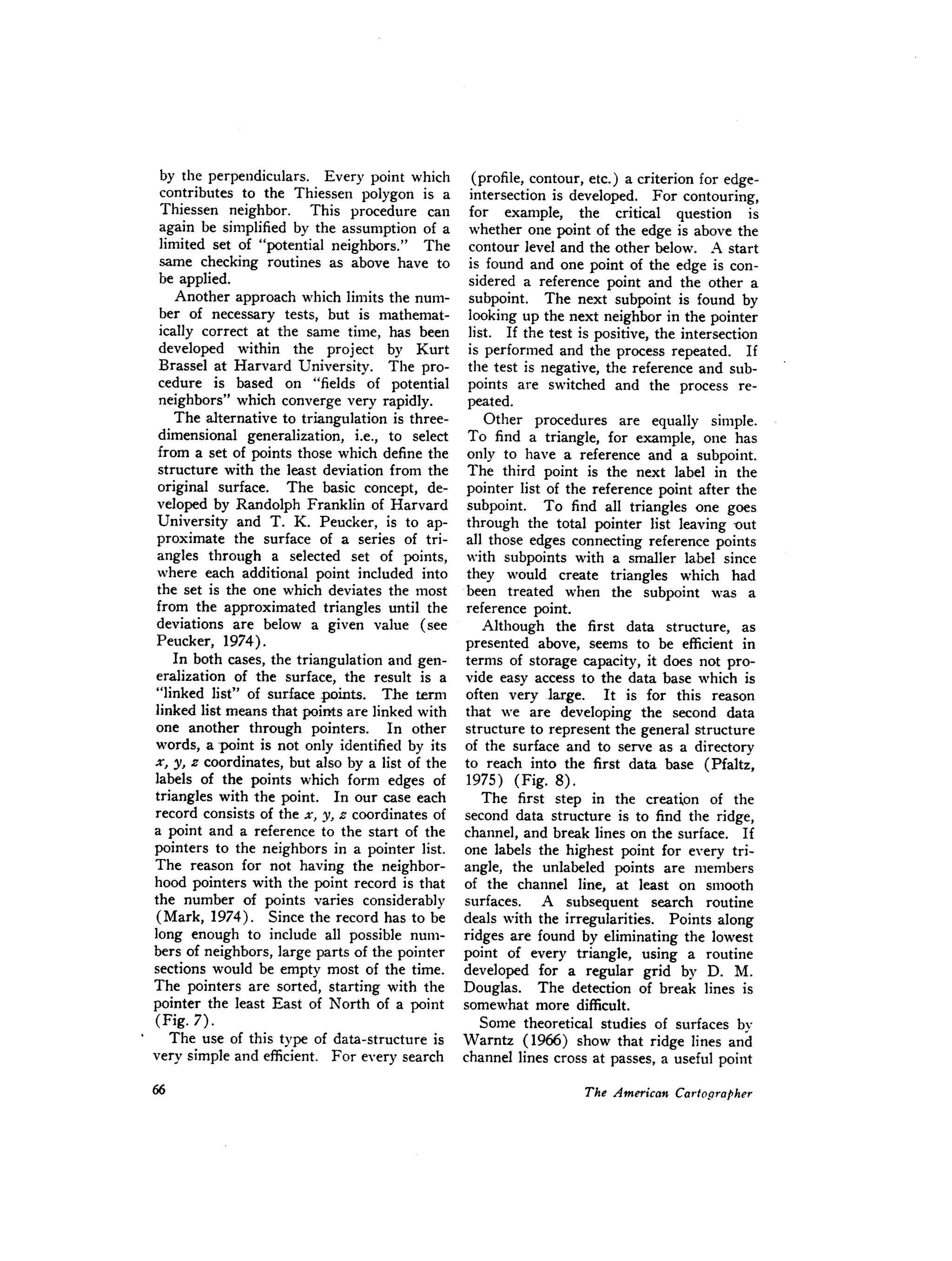
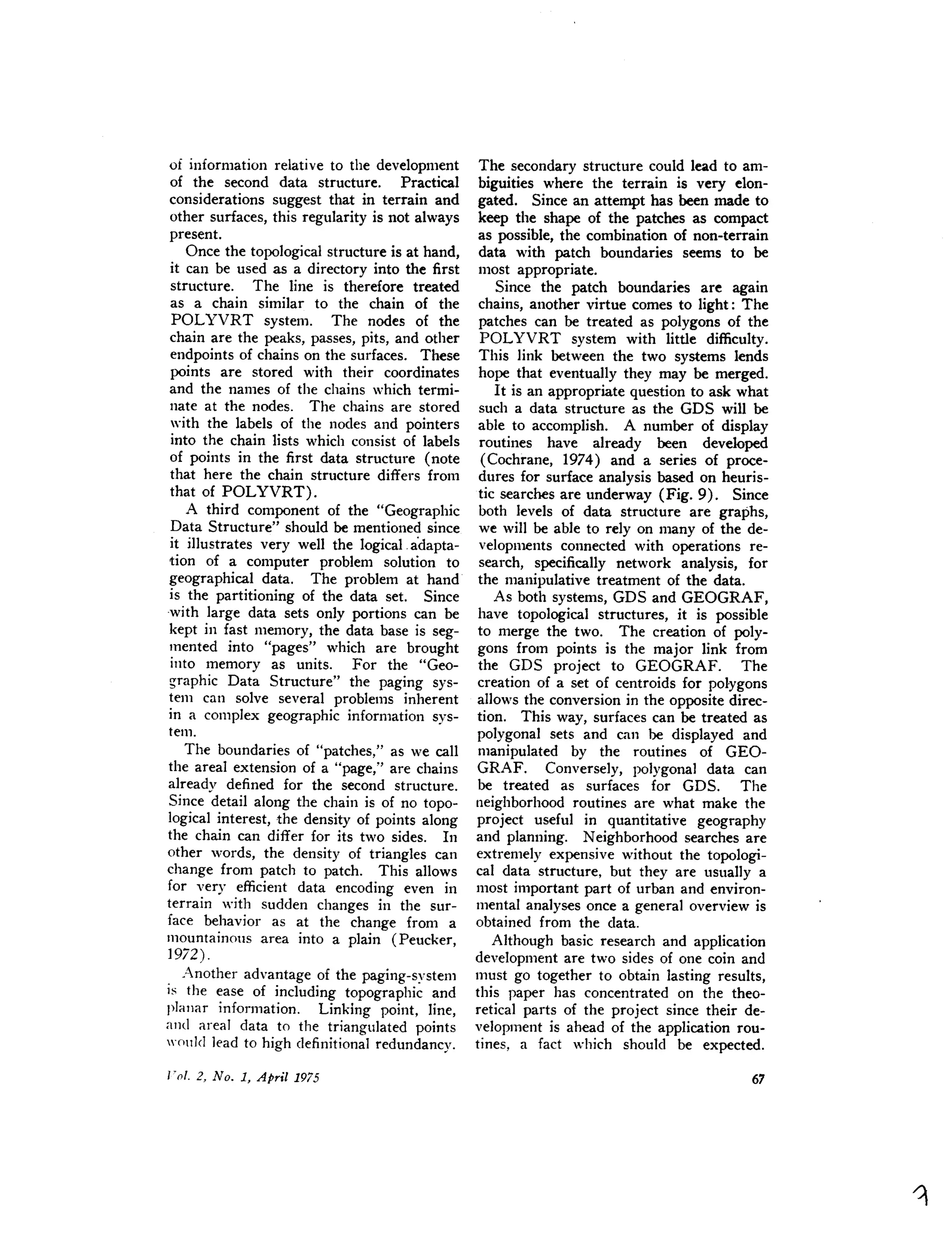
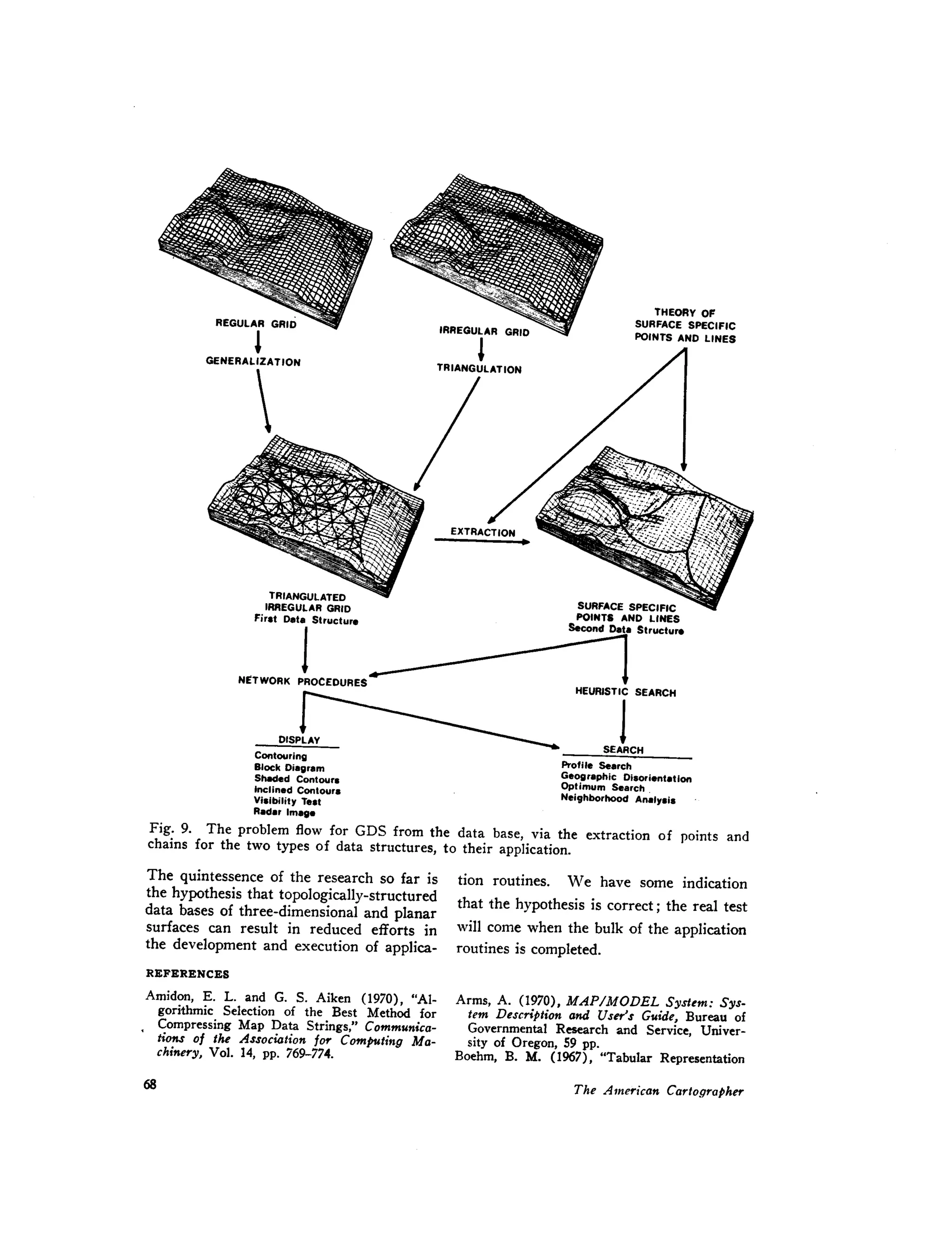
![of Multivariate Functions with Applications
to Topographic Modelling," Proceedings, 22nd
National Conference, Association for Comput-
ing Machinery, pp. 403-415.
Brandstaetter, L. (1957), "Exakte Schichtlinien
und Topographische Gelaendedarstellung,"
Oesterreichische Zeitschrift fuer Vermessungs-
wesen, Sonderheft 18, Wien, 90 pp.
Cochrane, Douglas (1974), "Cartographic Dis-
play Operations on Surface Data Collected in
an Irregular Structure," M.A. thesis, Simon
Fraser University.
Cooke, D. F. and W. F. Maxfield (1967), "The
Development of a Geographic Base File and
Its Uses for Mapping," Urban and RegiOJlal
Information Systems for Social Programs, Pa-
pers from the 5th Annual Conference of the
Urban and Regional Information System As-
sociation, pp. 207-218.
Douglas, David H. (1973), "BNDRYNET,"
Peucker, T. K. (ed.) , The Interactive Map in
Urban Research, Final Report After Year One,
University of British Columbia.
Dueppe, R. D. and H. ]. Gottschalk (1970),
"Automatische Interpolation von Isolinien bei
willkuerlich verteilten Stuetzpunkten," Allge-
meine Vermessungs-Nachrichten, Vol. 129, No.
10 (Oct.), pp. 423-426.
Grist, M. W. (1972), "Digital Ground Models:
An Account of Recent Research," Photogram-
metric Record, Vol. 70, No.4 (Oct.), pp. 424-
441.
Heiskanen, W. A. and H. Moritz (1967), Phys-
ical Geodesy, W. H. Freeman, San Francisco,
Chapter 7.
Holroyd, M. T. and B. K. Bhattacharyya
(1970), Automatic Contouring of Geophysical
Data Using Bicubic Spline Interpolation, Geo-
logical Survey of Canada, Paper No. 70-55.
Hsu, M. L., et al., (1975), "Computer Applica-
tions in Land Use Mapping and the Minnesota
Land Management Information System," Da-
vis, J. c. and M. McCullagh (eds.), DisPlay
and Analysis of Spatial Data, New York, John
Wiley and Sons.
Junkins, ]. L., G. M. Miller and J. R. Jancaitis
(1973), "A Weighting Function Approach to
Modelling of Irregular Surfaces," Journal of
Geoph:!o,sicalResearch, Vol. 78, No. 11 (Apr.),
pp. 1794-1803.
Kraus, K. (1973), "A General Digital Terrain
Model," translation from an article in Acker-
mann, F. (1973), Numerische Photogram-
meme, Sammlung Wiechmann, Neue Folge,
Buchreihe. Bd. 5, Karlsruhe.
Laboratory for Computer Graphics and Spatial
Analysis, Harvard University (1974), POLY-
VRT Manual, Cambridge, Mass.
Mark, David M. (1974), "A Comparison of
Computer-based Terrain Storage Methods
With Respect to Evaluation of Certain Geo-
morphometric Measures," M.A. thesis, Uni-
versity of British Columbia.
Morse, S. P. (1968), "A Mathematical Model
for the Analysis of Contouring Line Data,"
Journal of the Association for Computing Ma-
chinery, Vol. IS, No.2, pp. 205-220.
Nake, F. and T. K. Peucker (1972), The Inter-
active Map in Urba" Research, Report after
Year 0,." University of British Columbia.
Nordbeck, S. and B. Rystedt (1970), "Isarithmic
Maps and the Continuity of Reference Interval
Functions," Geografiska Annaler, Vol. 52, Ser.
B., pp. 92-123.
Peucker, T. K. (1972), Computer Cartography,
Association of American Geographers, College
Geography Commission, Resource Paper No.
17, Washington, D.C.
Peucker, T. K. (ed.) (1973), The Interactive
Map in Urban Research, Final Report After
Year One," University of British Columbia.
Peucker, T. K. (1974), Geographical Data
Structures Report After Year One, Simon
Fraser University.
Pfaltz, J. L. (1975), "Surface Networks," Geo-
graphical Analysis (forthcoming).
Rhynsburger, D. (1973), "Analytic Delineation
of Thiessen Polygons," Geographical Analysis,
Vol. 5, No.2 (Apr.), pp. 133-144.
Rosenfeld, A. (1969), Picture Processing by
Computer, New York, Academic Press.
Schmidt, W. (1969), "The Automap System,"
Surveying and Mapping, Vol. 29, No. 1
(Mar.), pp. 101-106.
Shepard, D. (1968), "A Two-Dimensional Inter-
polation Function for Irregularly Spaced
Data," Proceedings, 23rd National Conference,
Association for Computing Machinery, pp. 517-
524.
Sima, J. (1972), "Prinzipien des CS digitalen
Gelaendemodells," Vermessungstechnik, Vol.
20, No.2, pp. 48-51.
Switzer, P. (1975) , in: "Sampling of Planar
Surfaces," Davis, J. C. and M. McCullagh
(eds.) , Display and Analysis of Spatial Data,
John Wiley and Sons, New York.
Tobler, W. R. (1969), "Geographical Filters and
their Inverses," GeograPhical Analysis, Vol. 1,
pp. 234-253.
Warntz, W. (1%6), "The Topology of Socio-
Economic Terrain and Spatial Flows," Papers
of the Regional Science Association, Vol. 17,
pp. 47~1. •](https://image.slidesharecdn.com/cartographicdatastructures-160221075257/75/Cartographic-data-structures-15-2048.jpg)